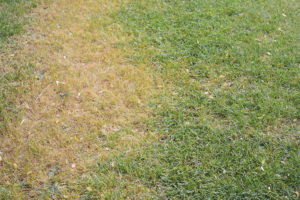
If you have browning grass, it’s important to determine if it’s dead or dormant so you can manage the problem appropriately.
When caring for your lawn, few things are more alarming than browning. In some cases, this can mean that the grass has died and will need to be diagnosed and replaced. However, in other cases, it just means that the grass has gone dormant. It’s important to know what kind of grass you have so you know what causes it to become dormant, and take some important steps to care for your vulnerable lawn during this period.
How to Determine the State of Your Grass
There are two ways to determine if your grass is dormant or dead:
- Do a tug test
- Identify how the lawn is browning
Tug Test
A tug test is exactly how it sounds. Grab a handful of grass, and give it a quick and firm tug. If it comes up without any resistance, it’s dead. If there is some resistance, then the grass is simply dormant, and it can be revived.
Browning Pattern
One of the easiest ways to determine if your grass is dead or dormant is to pay attention to the browning pattern. If the browning is patchy, this indicates death due to dehydration or disease. When grass is going dormant, it happens in a very uniform way so that the entire lawn will go dormant. If this is the case, the dormant grass can be revived.
How to Care for a Dormant Lawn
If your lawn is going dormant due to a drought season, there are a couple of important things to keep in mind. First, water your lawn deeply at the start of the drought period. This will help the soil retain moisture longer and give the crown of the grass blades a way to remain alive and have a chance to regrow. Water minimally during the drought period. If it lasts for more than 4 weeks, you will have to take matters into your own hands and begin watering it again to give it a chance to recover.
Things you should avoid include fertilizing and mowing too often. Mow only in the early morning or late evening, ensure the blades are sharp so that the grass isn’t damaged, and never take off more than ⅓ of the height of the grass. Weeds might make an appearance in full force during dormancy, and these will need to be kept under control. Pull them by hand or directly hit them with an herbicide. Do not get herbicide on your dormant grass—it could harm its ability to recover. It’s also important to keep foot traffic to a minimum during the dormancy period, as this damages the grass and can hamper its ability to recover.
What to Do if Your Grass is Dead
If your grass is dead, it simply will not spring back to life no matter what you do. If there are only patches of dead grass, it’s a good idea to determine what has caused the death and work to fix the core issue before seeding that area of the lawn. If a large portion of your lawn has died, it can be beneficial to have sod installed and start over with a fresh new lawn. Don’t forget to study up on how to care for new sod so your beautiful new lawn can establish itself and become the pride of your property.
Have More Questions? Stay in Touch!
Order early and order often to ensure the best service possible. Contact us through our online page. Please find us at 27616 Little Lane, Salisbury, Maryland 21801. Our phone number is 410-726-6103, and our fax number is 410-742-6550. Speak to Jason Anderson for Turf Grass Sales. Reach him by email at jason@quanticocreeksod.com. Finally, follow us on social media on Facebook, LinkedIn, and our blog!
